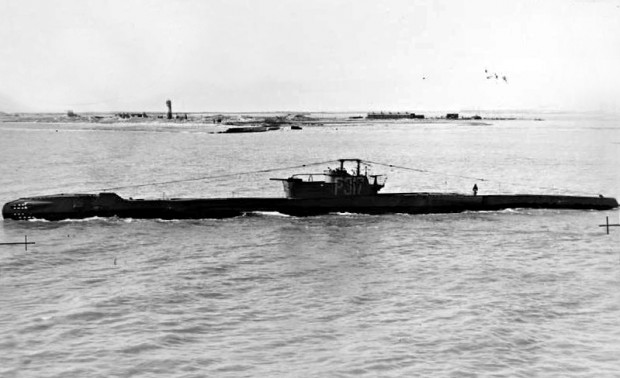1950s: Submarines ‘Snort’ From Bermuda To UK
In what was a ground breaking operation of that era, two submarines traveled from Bermuda the United Kingdom, staying underwater the entire time using a technique Navy personnel refer to as the “snort.”
“Snorting” means that the submarine is using a snorkel to to operate submerged while still taking in air from above the surface.
The Royal Navy’s HMS Andrew was the first submarine to cross the Atlantic staying underwater the entire time using the “snort” in May of 1953. The 15 day trip set a new record for continuous underwater operation.
The following year, the HMS Tally Ho also made the trip from Bermuda to the UK entirely underwater. The submarine – which was named by Sir Winston Churchill – took 3 weeks to complete the journey.
The British submarine Tally Ho which made the transatlantic trip in 1954:
In June of 1954, the Glasgow Herald reported, “Men in the submarine Tally Ho expect to see daylight today for the first time in three weeks, the time it has taken the craft to travel at ‘snorting’ depth across the Atlantic from Bermuda.
“The Tally Ho is due to surface at the entrance to the English Channel tonight, and she is expected to reach Portsmouth on Thursday evening.
“The object of the operation is to gain experience of the behavior of a ‘T’ class submarine in such conditions and to train personnel in ‘snorting’ techniques and submarine operations generally.
“The distance is about 2,800 miles, and the submarine started ‘snorting’ a few hours steaming from Bermuda.”
“A similar passage was made by the submarine Andrew last year, but this is the first made by a “T” class craft. The Andrew crossed from Bermuda entirely underwater, and surfaced off the southwest approaches of the English Channel on June 15.
“It was then stated that there was no record of a previous underwater crossing of the Atlantic. The crew maintained touch with the outside world by radio.”
Newspaper clipping from July 1, 1954 about the arrival of the Tally Ho
This was one of a few notable moments in submarine history involving Bermuda, which hosted a submarine base on Ordnance Island in St George’s back in the 1940s.
One submarine that left Bermuda has long been the subject of controversy and conspiracy theories, with the Free French sub “Surcouf” and her crew vanishing after leaving the island in 1942.
The 361 foot long vessel launched as the world’s largest submarine and, at the time of her loss, it was the greatest single submarine casualty ever.
The “Surcouf” left Bermuda in February of 1942, heading to the Panama Canal, and was never seen again, with all 127 members of the crew and three attached British seamen presumed dead.
Various theories have been proposed, including that she was deliberately sunk by the British or Americans, collided with a ship, was tailed by two subs from Bermuda, and of course some suggest the infamous Bermuda Triangle is to blame.
Another notable event in submarine warfare happened two years later, when a captured submarine was secretly hidden in Bermuda.
The German U-505 submarine was captured by the U.S. Navy in 1944, marking the first time an American Navy vessel had captured an enemy vessel at sea since 1815.
After being captured, the submarine was towed some 2,000 miles into Port Royal. The German crew, 58 of them, were also brought to Bermuda and held here for several weeks before been transported to a POW camp in Louisiana.
Information gleaned from the captured sub provided valuable intelligence about German naval equipment and codes, and the Americans wanted to avoid revealing the capture so the Germans wouldn’t be alerted and change their codes.
Since they deemed it so important to keep the U-505 capture a secret, the POWs were isolated from other prisoners, and the U.S. Navy confiscated all letters they attempted to send out.
The U-505 prisoners remained in the POW camp in Louisiana until the end of the war, while the submarine was moved from Bermuda and is now on display at a Chicago museum.




Thanks Bernews,I love these History Articles you post.